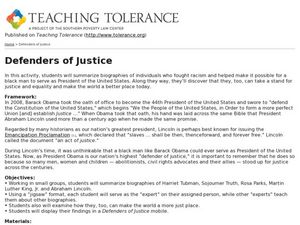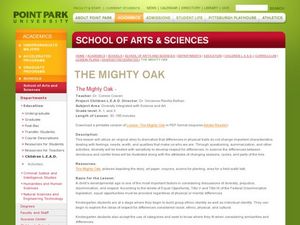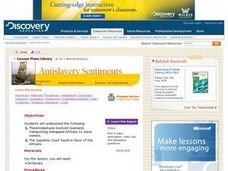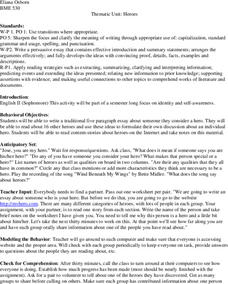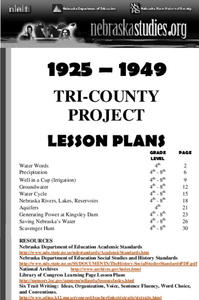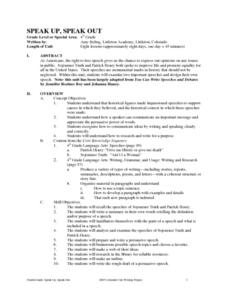Curated OER
Defenders of Justice
Students research abolitionists, civil rights advocates, and their allies to learn about racism and justice. In this racism and justice lesson, students define justice and sing a song about activism. Students review the biographies...
Curated OER
Kate Fowler: Tory Spy
Fourth graders study the American Revolution and several key aspects and people involved in it. In this American Revolution lesson, 4th graders study the land grant for British colonists. Students read the 'The Legend of Kate Fowler' and...
Curated OER
Painting Pottery
Learners summarize and illustrate the process of painting an ancient Greek vessel, identify the amphora as an example of the black figure style and order the steps and procedures necessary to produce an amphora in the black figure style.
Curated OER
The Very Hungry Caterpillar
First graders, after reading The Very Hungry Caterpillar, place the story in its correct order of sequence. They place any set of events (situation) in their correct order.
Curated OER
Geography in the News
Ninth graders are introduced to an article in which falls into one of the five themes of geography. They pick their own article and summarize it to the class.
Curated OER
Natural Resources
Young scholars use magazines and newspapers to examine the Earth's natural resources. They identify ways that natural resources are protected, threatened, managed and mismanaged. They find the location of each story on a world map and...
Curated OER
Nursery Rhymes
Students recall details of nursery rhyme read by teacher, identify main characters, and demonstrate knowledge of poem by creating concept map about story that includes title, clip art, and changes in font and color.
Curated OER
Using "Why Mosquitoes Buzz in People's Ears" to Teach Cause and Effect
Learners discuss cause and effect relationships and the chain reaction involved before listening to the story "Why Mosquitoes Buzz in People's Ears". Students create flow charts to show the chain reactions of causes and effects in the...
Curated OER
Where Does Water Come From: The Water Cycle
Students explore the water cycle. In this water cycle lesson, students read the book The Magic School Bus Wet All Over and summarize the steps of the water cycle. Students label a picture map of the water cycle.
Curated OER
The Mighty Oak
Young scholars investigate types of trees. In this forestry lesson, students read the book The Mighty Oak and act out the story with a partner. Young scholars discuss the types of trees in the book and plant an oak tree on school grounds.
Alabama Learning Exchange
Leo Lionni’s Little Blue and Little Yellow
Learners use the Internet to research the author Leo Lionni, then rewrite and illustrate one of his stories.
Curated OER
Sadako and the Thousand Paper Cranes
Third graders explore their culture in comparison to Japanese culture by reading the book, Sadako and the Thousand Paper Cranes. They identify islands of Japan, create a Venn diagram comparing Japanese culture to American culture, and...
Curated OER
Irony At Owl Creek
Students engage in study of literature in order to identify the use of irony in the context of reading two stories. They are compared and contrasted and the irony is exposed. The activities include the answering of several key questions.
Curated OER
Antislavery Sentiments
Students review the basic facts of the Amistad slave ship case. They are challenged to test their powers of close reading by being asked to summarize the decision handed down by the Supreeme Court of the United States in 1841. Students...
National First Ladies' Library
The Sport of Kings: Horse Racing in America
Pupils examine the history of horse racing. They discuss their experiences with horse racing and conduct Internet research. They select a topic related to the history of horse racing, write and present a report, and read and summarize a...
Curated OER
Online Museum Worksheet
In this technology worksheet, students research an online museum and select a topic within that museum. They read the story section and summarize it in a paragraph. Then students list five important things that they learned about the...
Curated OER
‘Pay it Forward’ Lesson Plan
Students develop their speaking skills. For this oral communication lesson, students read "One Hen" by Katie Smith Milway and work in groups to discover how making a small loan to the main character in the story had positive effects....
Curated OER
Hero Or Zero?
Students investigate science and technology by reading a children's book. In this reading comprehension lesson, students read the story Archibald Frisby and discuss the ways we use science and technology in everyday life....
Curated OER
Identify and Analyze Literary Concepts
Students explore plot structure, conflict, setting, and mood. In this literary elements lesson, students read Rosa Parks, My Story and complete the provided plot outline worksheets. Students discuss the text elements of non-fiction...
Curated OER
Heroes
Tenth graders participate in research and class discussion before attempting to write a traditional five paragraph essay. They use the examples of 16 other hero stories to consider. Students use examples and descriptive details to...
Curated OER
A Graphic Scene
Third graders discuss the advantages of using various graphic organizers including Venn Diagrams and T-charts. They use the organizers to compare and contrast different versions of classic mythological stories.
Curated OER
Scavenger Hunt
Students summarize the "Tri-County Project" section of the nebraskastudies.org web site using a scavenger hunt.
Curated OER
Speak Up, Speak Out
Fourth graders examine, compare, and summarize the speeches of Sojourner Truth and Patrick Henry. They review the parts of a good speech and design and give their own speech that expresses an opinion and persuades the listener..
Curated OER
What are Conductors and Insulators?
Students explore simple circuits. Students conduct a variety of experiments to discover their level of conductivity. Students summarize and explain experimental findings. Students are introduced to passive causality.
